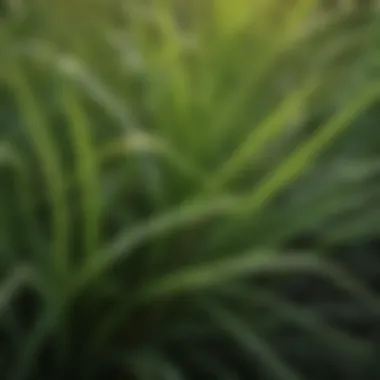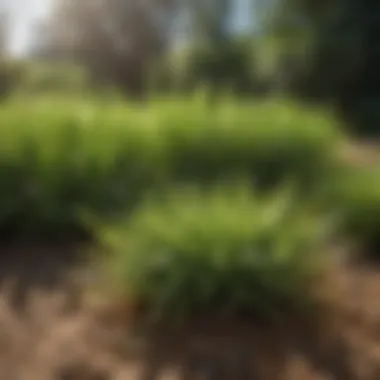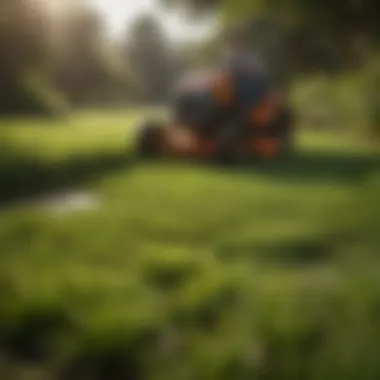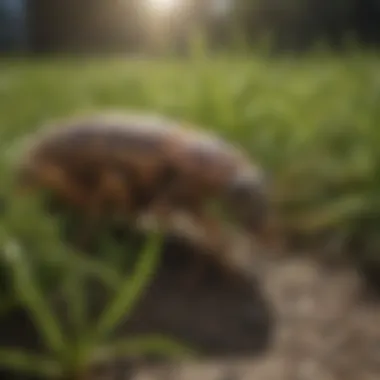Exploring St. Augustine Grass Varieties: A Comprehensive Guide


Intro
St. Augustine grass is a warm-season turfgrass known for its lush appearance and adaptability. It has become a popular choice for lawns in the southern United States due to its ability to withstand heat and humidity. This article aims to provide a detailed examination of St. Augustine grass varieties, focusing on characteristics, ideal growing conditions, maintenance practices, and pest control methods.
Understanding the different varieties and their unique needs is essential for gardeners and agricultural professionals alike. With this knowledge, one can make informed decisions on grass selection that promote healthy lawns and sustainable practices.
Key Concepts and Terminology
Basic Definitions
St. Augustine grass (Stenotaphrum secundatum) is a perennial grass that is commonly used for lawns, golf courses, and parks. This grass variety is characterized by its broad, dark green blades and dense growth habit. Here are some key terms associated with St. Augustine grass:
- Variety: A specific type of St. Augustine grass with distinct characteristics. Common varieties include Floratam, Palmetto, and Raleigh.
- Warm-season grass: Grass that grows best in warm temperatures, typically thriving from late spring to early fall.
- Turfgrass: Grass bred and cultivated for lawns, sports fields, and recreational areas.
Historical Context
Historically, St. Augustine grass was introduced to the United States from the Caribbean. Its ability to adapt to various soil types and growing conditions led to its quick adoption, especially in warmer climates. Over the years, cultivators have developed different varieties, each exhibiting specific features aimed at improving resilience and aesthetics.
Recent Innovations and Trends
Technological Advancements
Advancements in grass breeding techniques have allowed for the development of St. Augustine grass varieties with improved traits. These include:
- Enhanced disease resistance, particularly to pests such as grassy stem maggot and brown patch fungus.
- New sod production methods that reduce costs and provide faster establishment.
Sustainable Practices
As environmental concerns grow, sustainable lawn care practices have also taken precedence. Some methods for maintaining St. Augustine grass sustainably include:
- Utilizing organic fertilizers to promote healthy growth.
- Implementing effective irrigation practices to reduce water consumption.
- Encouraging biodiversity by incorporating native plants and reducing chemical applications.
Practical Applications and Techniques
Step-by-step Guides
Here is a brief guide to establishing and maintaining St. Augustine grass:
- Site Preparation: Test the soil pH and amend it as necessary. Clear the area of debris.
- Choosing the Right Variety: Select a variety based on local climate and lawn usage.
- Establishment: Plant sod or seed in the spring when temperatures are consistently warm. Water regularly until the grass is established.
- Maintenance Practices: Mow regularly to encourage lateral growth. Fertilize according to the recommended schedule for your variety.
- Pest Control: Regularly inspect the lawn for pests and diseases. Implement integrated pest management practices.
Case Studies
Examining successful St. Augustine grass installations highlights the importance of choosing the right variety based on the local environment and intended use:
- Residential Lawns: Homeowners who planted Floratam reported its rapid growth and ability to withstand high foot traffic.
- Commercial Spaces: Areas utilizing Palmetto demonstrated its drought tolerance and minimal maintenance requirements, making it ideal for low-maintenance landscapes.
"Choosing the right St. Augustine variety can make a significant difference in lawn health and aesthetic appeal."
Understanding these varieties and their specific needs allows for better lawn care strategies, ultimately leading to healthier and more sustainable grass management.
Prolusion to St. Augustine Grass
St. Augustine grass holds a notable place in landscaping and turf management, particularly in warmer climates. Understanding its characteristics and needs is crucial for creating and maintaining healthy lawns. The versatility of St. Augustine grass allows it to flourish in various settings, making it a popular choice among gardeners and homeowners alike.
Origins and Historical Significance
St. Augustine grass (Stenotaphrum secundatum) originated in tropical and subtropical regions, primarily found in the coastal areas of the Caribbean, the southern United States, and parts of Africa. Historically, this grass was brought to the United States in the 19th century, quickly establishing itself as a staple for lawns and parks in warm regions. Its adaptability to sandy soils and tolerance of saltwater has made it an ideal option for coastal areas.
In addition to its ornamental value, St. Augustine grass played a role in erosion control. Its dense growth habit helps secure soil, reducing the risk of damage from wind and water. The grass has gone through extensive breeding to enhance various traits, such as color, drought resistance, and disease tolerance. This historical significance illustrates not just an evolution of a plant but also a response to changing environmental demands over time.
Common Uses in Landscaping


St. Augustine grass finds application in diverse landscaping scenarios. Its lush appearance and rich green color make it visually appealing for residential lawns. Many homeowners choose this grass for its ability to provide a thick, carpet-like lawn that enhances property value.
Moreover, St. Augustine is commonly used in commercial landscapes, parks, and recreational areas. Below are some specific uses:
- Residential Lawns: Popular for its aesthetic qualities and comfort underfoot.
- Golf Courses: Provides a dense surface ideal for maintaining high playability.
- Parks and Playgrounds: Suitable for heavy foot traffic due to its durability.
Additionally, its relatively good shade tolerance makes it a preferred choice for shaded areas where other grasses may struggle. However, while St. Augustine grass has numerous benefits, maintenance practices must align with its growing conditions to achieve optimal growth.
> Understand the importance of selecting the right grass for your specific environment to ensure long-term success in your landscaping efforts.
Distinct Varieties of St. Augustine Grass
Understanding the distinct varieties of St. Augustine grass is crucial for anyone involved in lawn care or landscaping. Each variety possesses unique characteristics that make it suitable for different environments and uses. This section will explore the specific varieties in detail, including their growth traits, optimal growing conditions, and maintenance needs. Choosing the right variety is essential to achieve not only a healthy lawn but also a sustainable one.
Floratam
Growth Characteristics
Floratam is perhaps the most recognized St. Augustine variety. It is known for its rapid growth and dense coverage. This grass type can establish itself quickly, making it a favorable option for those seeking immediate results in their lawns. A notable characteristic is its light green color, which tends to stay vibrant throughout the growing season. However, its quick growth requires more frequent mowing to maintain an ideal height, which can be seen as a drawback for some homeowners.
Optimal Growing Conditions
Floratam thrives in warm climates, requiring full sunlight for at least six hours a day. It does well in sandy or loamy soils but does have a medium tolerance for drought conditions. One unique feature is its ability to withstand some salinity, making it adaptable for coastal areas. However, it is susceptible to cold temperatures, which can limit its growing region.
Maintenance Requirements
Maintaining Floratam involves regular mowing, approximately every 7 to 10 days. It also benefits from a balanced fertilization schedule, ideally with a nitrogen-rich fertilizer. Proper irrigation, especially during dry spells, is critical. This variety requires more inputs than some others, potentially leading to higher maintenance costs.
Palmetto
Growth Characteristics
Palmetto is characterized by its dark green color and broad blades. It has a slower growth rate compared to Floratam, which can be a benefit for those looking for less frequent lawn maintenance. Its dense growth pattern provides excellent coverage and helps suppress weeds naturally. Palmetto is favored for its tolerance to shade, making it suitable for lawns with partial sun exposure.
Optimal Growing Conditions
This variety performs well under partial shade and is more tolerant of varying soil types. Palmetto can adapt to a range of moisture levels, though it prefers well-draining conditions. The versatility of this grass makes it a strong candidate for different landscapes. While it does not require extreme heat, it shouldn't be exposed to frost.
Maintenance Requirements
Palmetto requires less mowing than Floratam, which appeals to busy homeowners. Fertilization should be done periodically, with an emphasis on potassium and phosphorus to enhance growth. Irrigation should be managed to prevent overwatering, as it is prone to disease in overly wet conditions. This balance makes Palmetto easier to care for in some respects.
Azure
Growth Characteristics
Azure is a relatively newer variety, known for its fine texture and vibrant color. Its growth is moderately fast and offers good durability against foot traffic. A standout feature is its rich green hue, which tends to hold color well, even in less-than-ideal conditions. Gardening enthusiasts appreciate Azure for its aesthetic appeal and resilience.
Optimal Growing Conditions
Azure flourishes in sunny locations and is adaptable to various soil types, though it prefers well-draining sandy soils. Its drought tolerance is moderate, requiring regular watering in dry months. The ability to withstand a variety of environmental stresses makes Azure an appealing choice for many lawns.
Maintenance Requirements
This variety requires standard lawn care practices. Regular mowing and appropriate fertilization are necessary to maintain its health and appearance. Azure does well with a soil test to determine specific nutrient needs, allowing for targeted fertilization. It may require more attention during peak growth times, but overall, it has manageable maintenance demands.
Raleigh
Growth Characteristics
Raleigh is recognized for its sturdy nature and ability to tolerate cooler climates. The grass has a medium texture and deep green color, contributing to a thick lawn. One unique aspect of Raleigh is its ability to establish sooner in colder months, which can be a significant advantage for northern areas.
Optimal Growing Conditions


This variety prefers full sun but can tolerate some shade. Raleigh can adapt to various soil types as long as there is sufficient drainage. It requires moderate watering, particularly in hot months, but is generally considered drought-resistant. This adaptability makes Raleigh suitable for diverse planting environments.
Maintenance Requirements
Raleigh needs regular mowing, although its slower growth rate means less frequent cutting. Fertilization should include both nitrogen and phosphorus, particularly in the spring. Adequate irrigation will support healthy growth, especially during dry spells. Its overall maintenance is lower compared to faster-growing varieties, making it a practical choice for many homeowners.
Growing Conditions for St. Augustine Grass
The successful cultivation of St. Augustine grass depends on understanding its growing conditions. This grass variety thrives when specific environmental factors, such as soil composition, sunlight, and water availability, are properly managed. Knowing these conditions can help gardeners and agricultural professionals create a robust, healthy lawn. Proper attention to growing conditions enhances the aesthetic appeal and usability of lawn spaces, making it vital for effective landscaping.
Soil Requirements
Soil is the foundation of any healthy grass, and St. Augustine grass is no exception. Its overall health and growth are directly related to soil quality and composition.
Soil pH Levels
Soil pH levels are a critical factor in determining nutrient availability to the grass. Ideally, St. Augustine grass prefers a pH range between 6.0 and 7.5.
- If the pH is too low (acidic), it may hinder nutrient absorption, leading to deficiencies.
- Conversely, a high pH (alkaline) can also restrict important minerals, impacting grass health.
Maintaining optimal pH levels can improve grass vigor, making it a significant consideration. Soil amendments can assist in balancing pH, though they must be applied judiciously to avoid disrupting the existing soil ecosystem.
Nutrient Needs
Nutrient needs are equally important for St. Augustine grass. This grass variety requires high amounts of nitrogen, phosphorus, and potassium for healthy growth.
- Nitrogen is vital for lush, green growth and is often a defining characteristic for healthy lawns.
- Phosphorus promotes root development, allowing grass to establish strong foundations.
- Potassium aids in overall plant health, helping the grass resist diseases and stress.
These nutrients can be sourced from fertilizers, yet it is essential to conduct soil tests beforehand. This ensures applying the correct amounts to achieve the desired lawn condition without the risk of over-fertilization, which can lead to more problems than benefits.
Sunlight and Water Needs
St. Augustine grass flourishes best in full sun, preferring at least six to eight hours of sunlight daily. However, it can adapt to partial shade.
Appropriate watering practices are crucial. St. Augustine grass requires deep, infrequent watering to establish strong root systems. Aim for a total of about 1-1.5 inches of water per week, either through rainfall or irrigation. This attention to sunlight and water ensures vigorous growth, contributing directly to the overall health and appearance of the lawn.
Maintenance Practices for St. Augustine Grass
Maintaining St. Augustine grass is essential for achieving a lush, healthy lawn. Proper maintenance practices help ensure that the grass thrives, promotes a robust root system, and remains aesthetically pleasing. This section outlines the key maintenance techniques that contribute to optimal grass health while addressing considerations that can impact longevity and resilience.
Mowing Techniques
Mowing is a critical factor in the maintenance of St. Augustine grass. It directly influences grass density, health, and overall appearance. The recommended mowing height for St. Augustine grass is between two and four inches. Mowing too low can stress the grass, making it vulnerable to diseases and pests.
One important technique is to follow the one-third rule, which states that no more than one-third of the grass blade should be removed at any mowing session. This practice helps keep the grass vigorous and allows it to recover faster. Additionally, it is ideal to mow when the grass is dry to avoid clumping and uneven cuts.
"Mowing at the correct height and frequency enhances St. Augustine grass density, improving its ability to withstand environmental stresses."
Fertilization Strategies
Fertilization is necessary to provide the essential nutrients that St. Augustine grass requires for growth. The nutrient needs may vary, depending on soil quality and existing nutrient levels. A test of the soil can determine the precise needs, but generally, St. Augustine grass thrives with a balanced nitrogen, phosphorus, and potassium ratio.
It is advisable to apply a slow-release fertilizer during the growing season. Typically, a nitrogen-rich fertilizer is suitable in the spring, while a lower nitrogen formulation is better for fall application to prepare the grass for cooler weather. Over-fertilizing can lead to rapid growth that stresses the lawn.
Key Considerations for Fertilization:
- Follow local guidelines to avoid runoff and pollution.
- Space out fertilization to keep growth steady without overwhelming the grass.
- Adjust the formulation based on specific variety needs.
Irrigation Best Practices
Irrigation is essential for maintaining healthy St. Augustine grass. This grass type prefers moist, well-drained soils and requires about one inch of water per week. However, factors such as rainfall, temperature, and soil conditions should influence the irrigation schedule.
Drip irrigation or soaker hoses can be beneficial as they minimize water waste and deliver moisture deep into the root zone. Timing irrigation in the morning helps reduce evaporation and disease risk. It is important to avoid overwatering, as it can lead to shallow root growth and susceptibility to pests.


Tips for Effective Irrigation:
- Monitor soil moisture levels before watering.
- Use rain sensors to optimize scheduling.
- Water deeply but infrequently to encourage robust root development.
In summary, effective maintenance of St. Augustine grass requires thoughtful implementation of mowing, fertilization, and irrigation practices. By focusing on the unique needs of the grass and adjusting care accordingly, one can achieve a thriving and resilient lawn.
Pest Management for St. Augustine Grass
Pest management is an essential aspect of maintaining healthy St. Augustine grass. The presence of pests can lead to significant damage, reducing the overall quality and resilience of the turf. Understanding the types of common pests and implementing effective management strategies helps ensure the longevity and attractiveness of lawns. This section explores key pests affecting St. Augustine grass and introduces integrated pest management techniques, highlighting their importance in sustainable agricultural practices.
Common Pests
Chinch Bugs
Chinch bugs are small, black insects known for their destructive feeding habits. They primarily thrive in warm climates, making them a common threat for St. Augustine grass. These pests feed on the grass blades, extracting sap and causing localized yellowing or browning. A notable characteristic of chinch bugs is their ability to reproduce rapidly; a few individuals can quickly turn into an infestation. Their small size allows them to be invisible until damage becomes apparent.
The significance of chinch bugs in this context lies in their capacity to severely impact grass health. They are particularly harmful during hot and dry conditions when grass is already stressed. The unique feature of their feeding, which disrupts the photosynthesis process, can lead to larger patches of dead grass if not addressed in a timely manner.
Gray Leaf Spot
Gray leaf spot is a fungal disease that affects St. Augustine grass, leading to leaf discoloration and death. This disease shows up as small gray or tan spots on blades. A key characteristic of gray leaf spot is its ability to spread quickly, particularly in high humidity and warm temperatures. It is popular to note that a proper understanding of this fungus is crucial for effective management.
A unique feature of gray leaf spot is its impact on older, stressed grass. If not identified early, it can lead to widespread damage, contributing to a decline in the lawn's overall appearance. While cultural practices can help reduce risk, acknowledging gray leaf spot's signs and knowing how to manage it are vital for lawn care success.
Integrated Pest Management Techniques
Integrated pest management (IPM) techniques are crucial for managing pests in St. Augustine grass effectively. IPM involves combining cultural, biological, and chemical methods to reduce pest populations sustainably. This approach minimizes reliance on chemical pesticides, promoting environmental health and safety.
Some key tactics in IPM for St. Augustine grass include:
- Monitoring: Regularly inspect the lawn for any signs of pests or diseases.
- Cultural Practices: Maintain healthy grass through proper mowing, watering, and fertilization to reduce stress, making it less vulnerable to pest attacks.
- Biological Controls: Utilize natural predators or parasites of pests, such as ladybugs or predatory nematodes, to help control chinch bugs.
- Chemical Controls: If necessary, apply targeted pesticides, ensuring they specifically address the pests threatening the lawn while causing minimal harm to beneficial organisms.
By employing a comprehensive IPM strategy, gardeners and agricultural professionals can manage pest issues in St. Augustine grass effectively, promoting a healthier landscape.
Understanding pests and their management practices is crucial in maintaining the beauty and health of St. Augustine grass.
Environmental Considerations
Understanding environmental aspects when cultivating St. Augustine grass is vital. The implications of grass selection extend beyond aesthetic values; they encompass ecological balance, resource management, and sustainability. Farming practices need to align with environmental standards to ensure both the health of the lawn and adherence to broader agronomic responsibilities.
Sustainability Practices
Sustainability in grass management is not just a trend but an essential practice. Choosing St. Augustine grass should reflect consideration for the local ecosystem. Implementing sustainable practices can minimize negative impacts on the environment. Some approaches include:
- Organic Fertilizers: Utilizing organic fertilizers reduces chemical runoff that can pollute waterways. These fertilizers improve soil health over time and support better grass growth.
- Native Plant Integration: Including regional plants alongside St. Augustine grass can promote biodiversity. This method encourages natural pest control by attracting various beneficial insects.
- Soil Health Management: Regular testing of soil health ensures optimal pH and nutrient levels. Healthy soil underpins strong grass growth, reducing the need for intensive chemical inputs, which can harm the environment.
Water Conservation Techniques
Water is a critical resource in crop and lawn maintenance. Efficient water use is central to cultivating St. Augustine grass while promoting sustainable practices. Implementing water conservation methods can lead to significant savings and better grass health. Here are some widely recommended techniques:
- Drip Irrigation Systems: Instead of traditional sprinkler systems, drip irrigation delivers water directly to the plant roots. This method minimizes evaporation and runoff.
- Mulching: Applying mulch around the grass reduces water loss through evaporation. Organic mulches also enhance soil quality over time as they decompose, continuing to support strong grass growth.
- Rainwater Harvesting: Capturing rainwater can provide an alternative water source for irrigation. This practice lessens dependency on municipal water supplies and takes advantage of a natural resource.
Implementing water conservation techniques not only supports grass health but strengthens local ecosystems and cultivates good agricultural practices.
The End
In this article, we have explored the various dimensions of St. Augustine grass, focusing on distinct varieties, optimal growing conditions, maintenance, and management strategies. The significance of this conclusion is to synthesize the critical elements discussed and highlight their importance in practical settings.
Recap of Key Points
St. Augustine grass is differentiated by its several varieties, such as Floratam and Palmetto, each having unique traits suited for different environments. Critical factors affecting their growth include soil conditions, sunlight, and water availability. Understanding maintenance practices like mowing and fertilization is vital for ensuring a robust lawn. Furthermore, effective pest management strategies can mitigate risks associated with common pests.
"A well-informed selection can lead to a thriving lawn and enhance aesthetic appeal in landscaping."
Proper practices not only promote healthy grass but also foster sustainability within lawn care. The integration of water conservation techniques plays a significant role in safeguarding resources.
Future Trends in Grass Varieties
The landscape of grass varieties continues to evolve, influenced by climate change and advancements in horticultural practices. It is likely that new hybrid varieties of St. Augustine grass will emerge, designed to withstand harsher weather conditions and resist diseases.
Research into genetically modified species may also gain traction, providing enhanced resilience and a reduced need for chemical treatments.
Additionally, environmentally-friendly practices are expected to become standard, driving the adoption of increased sustainability measures. Innovations in water-saving practices and organic fertilizers will likely gain popularity among farmers and enthusiasts alike.















